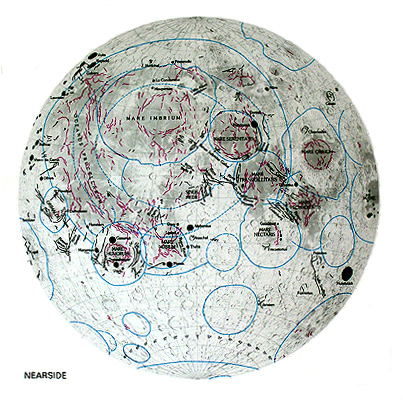February 27, 2004
Structures of the Lunar Surface
Image Credit: Geologic History of the Moon |
|
Structures of the Lunar Surface Structural geology is the study of the landforms caused by horizontal or vertical movement of the crust. On Earth, much of structural geology concerns faults and folds created by the forces of plate tectonics. On the Moon, most structural or tectonic features appear to be associated with impact basins. The image above is another from the lunar bible: Don Wilhelms' Geologic History of the Moon. Overlaying a faint image of the Moon are a series of lines, circles and dots. Here is what they mean. The blue circles are the main rims of impact basins - the circle is dashed where there is uncertainty of its exact position or even existence. The largest circle is for the Procellarum or Gargantuan Basin - it really should be dashed! The red, slightly wiggly lines are wrinkle (or mare) ridges. In some basins (e.g. Crisium, Serenetatis, Imbrium) they define basin inner rings. In other cases (Fecunditatis and Nubium) it is unclear what they signify. Black lines are faults - linear fractures thru the crust - and many are flat-floored rilles such as the Ariadaeus. Others are faults with vertical movements such as the Straight Wall and the Cauchy fault. And others are radial linear features such as the Alpine Valley and concentric rilles (Humorum and Tranquillitatis). Black circles are floor-fractured craters such as Posidonius and Gassendi. Note how all of these features cluster near maria - and as you should expect, there are almost no tectonics features on the mare-poor farside. Yesterday's LPOD: On the Moon with Apollo 15 Tomorrow's LPOD: Angular Basin |
|
Author & Editor: |
COMMENTS?
Register, Log in, and join in the comments.




